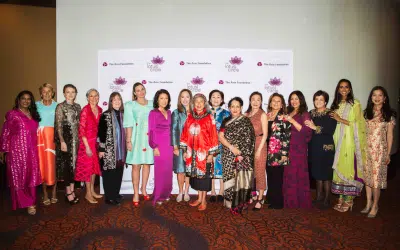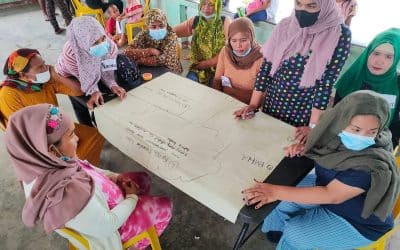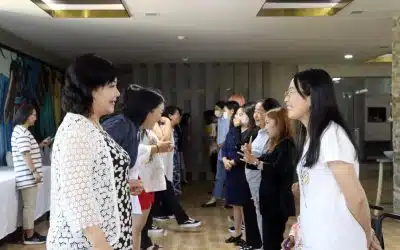InAsia
Insights and Analysis
Civic Peacebuilding on the Rise in the Asia-Pacific
June 28, 2023

The Democracy Monument in Bangkok, Thailand. (Nawit science / Wikipedia CC BY-SA 4.0)
Polarized politics, democratic deficits, rampant online hate speech, unprecedented global security risks. In this turbulent era, how do peace campaigners and grassroots mobilizers bridge bitter divides and promote peace in their communities?
A forthcoming study reveals that peacebuilders are finding new opportunities in this tough environment. In a project with the Initiative for Peacebuilding at the University of Melbourne, The Asia Foundation interviewed 25 civil society leaders in South and Southeast Asia—women and men, young and old—who work to prevent conflict. While acknowledging that space to speak out is shrinking in many countries, they expressed hopeful views of current opportunities to mediate and resolve conflicts.
The study suggests that people are finding new ways to promote change and hold governments to account. From Sri Lanka to Timor Leste, emerging civic movements have been active both in the streets and online, as citizens harness social media to seek reforms. These new protests have tended to be flexible, responsive, and overtly political.
Young people are becoming more vocal, and young women are increasingly central to these movements. This new generation is more urban, more educated, more diverse, and more politically aware. Older NGOs and traditional funders such as foundations and international donor agencies remain important, but the growing affluence of the Asia-Pacific region is fostering local funding sources and new ways of mobilizing.
An era of tensions
These emerging movements face many challenges. As authoritarian tendencies have eroded democratic norms worldwide, many Asia-Pacific governments are asserting greater control of mass media and adopting new surveillance technologies. Expressions of ethnic nationalism have also spread as politicians aggravate divisions and erode democratic institutions, drumming up resentment and blaming vulnerable groups to build their own political support. They routinely harness the same social media used in street protests and reform movements.
These trends have repeatedly threatened the rights of minorities, and deadly majoritarian violence, perpetrated mainly by organized and often politically connected mobs, has broken out in several countries. The most extreme violence has occurred in Myanmar, where organized mobs and later the armed forces mounted deadly attacks on the nation’s Rohingya minority, leading to thousands of fatalities and hundreds of thousands of refugees. Elsewhere, violence has been less deadly but has still uprooted communities and caused widespread fear.
Recent economic problems have raised the pressure. Inflation and the strain of the pandemic on national budgets are keenly felt in cities and villages across the Asia-Pacific. Decades of economic growth have raised popular expectations for a decent job and more consumer purchasing power, and resentment spreads easily when opportunities dry up for the many amid prosperity for the well-connected few. Combined with more authoritarian leadership and polarizing politics, this frustration can easily spark urban protest or descend into violence.
These risks are unfolding on the ground at a time of rising geopolitical strains, and the Asia-Pacific region lies at the heart of these tensions. No longer a dry topic for foreign policy analysts and Cold War historians, geopolitics is now big news. Western nations and Japan have announced an array of new policies, “pivots,” and “tilts” that emphasize their concerns over the region’s security and its importance to global commerce. As China’s influence grows, other rapidly emerging Asian nations are also looking to expand their regional footprint. In this emerging multipolar world, the rules are increasingly unclear, and the risk of international confrontation is rising. The knock-on impact of these pressures on domestic tensions across the region is hard to predict.

Democracy monument in Thailand guarded by soldiers. (Photo: The Asia Foundation)
Opportunities and progress
This is, overall, a gloomy picture. And yet statistics tell a story of recent decades that is very different, a story of declining violence in the Asia-Pacific. Excepting Afghanistan, where the carnage of war was of a different scale, deaths from armed conflict in the region have steadily dropped. Two decades ago, at the start of this century, annual casualties from war were measured in tens of thousands. Now they hover in the single-digit thousands. Various datasets confirm that this is a significant change, not a statistical anomaly.
In many places where warfare has persisted, casualties have declined. For example, in several conflict-affected parts of India and in Thailand’s far South, state security forces have been able to reduce levels of violence. As economies have grown, so has the capability of governments to deploy new surveillance technologies and impose security measures. A recent study shows that while government spending on internal security in India has remained constant as a proportion of the economy since the 1980s, high growth rates have brought a tenfold increase in the overall security budget.
A trend toward stronger state security fits the broader patterns already discussed, especially rising authoritarianism and declining liberal values. Yet these cases of “imposed peace” are only part of the story. In many other examples, adversaries have found ways to tackle the root causes of conflict or at least to establish a working compromise. In the southern Philippines, after years of groundwork, a peace agreement has transferred authority to former insurgents and sought to strengthen local autonomy while respecting the unity of the nation. The Indian government has brokered agreements with an array of local armed groups and movements in its restive Northeast. And in Nepal, negotiations brought a bloody civil war to a difficult yet ultimately broadly successful end and laid the foundations for a new federal system.
These peace processes have not always centered on narrow deals between rival leaders, and other groups have often played a vital role. International organizations and neighboring countries have stepped in to support dialogue and guarantee agreements, while domestic civil society has been effective in finding solutions to long-standing domestic conflicts.
Just as governments have increased their resources and security capabilities, civic leaders have grown stronger and more capable with the involvement of new generations. By spreading support for change, building coalitions, and developing new approaches to conflict resolution, local peacebuilders and civic leaders have effectively supported peace talks and reform even when they have not had a seat at the negotiating table.

(Photo: The Asia Foundation)
Civil society has also advocated effectively for political reforms and new policies that are essential to ending violent conflicts, from the civil war in Nepal to the tumultuous recent political changes in Sri Lanka. Popular participation and street mobilization seeking to hold elites to account have been a force for progress in Malaysia, Thailand, and elsewhere. As new challenges emerge in this time of rising tension, division, and mistrust, the resources to find a path forward have expanded across the Asia-Pacific.
Whether addressing political instability, repression, or violent conflict, civic peacebuilders appear well-equipped to support the search for lasting solutions, harnessing new generations and new technologies in the process. As Western-leaning nations seek stronger diplomatic ties and bolster their military capabilities to allay their security concerns, they must also recognize the essential contribution of civic leaders and social movements to the search for peace and stability and find ways to support their work.
Adam Burke is senior director of The Asia Foundation’s Conflict and Fragility program. He can be reached at [email protected]. The views and opinions expressed here are those of the author, not those of The Asia Foundation.
About our blog, InAsia
InAsia is posted and distributed every other Wednesday evening, Pacific Time. If you have any questions, please send an email to [email protected].
Contact
For questions about InAsia, or for our cross-post and re-use policy, please send an email to [email protected].The Asia Foundation
465 California St., 9th Floor
San Francisco, CA 94104
The Latest Across Asia
News
April 25, 2024
Program Snapshot
April 18, 2024
News
April 17, 2024

2024 Lotus Leadership Awards
The Lotus Leadership Awards recognize contributions towards gender equality in Asia and the Pacific







0 Comments